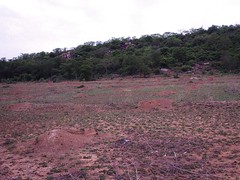The search for a suitable land was into its sixth frenetic week when on June 17, Manoharan, a fisherman of my village Muttukkadu, said: “I have just the kind of property you have in mind. A friend has the details. Give me a day, for me to go visit it and confirm it meets your needs.”
I repeated my specs: it must be within 100 km of Chennai, be a wasteland abandoned as non-productive, be on sloping ground by a hill placed right Vaastu-wise. There should be mobile phone access and a town within 10 km but not much closer than that. Manoharan nodded to mean, ‘I know, I know.’
On June 18, he called from the property. As he described what he saw around him and answered my pointed questions, my heart beat faster. It sounded just right. In 2003 I had searched in those areas for land and knew there were hillocks there. He said there were about 32 acres available and it seemed the right size.
On June 19, we both drove there taking the East Coast Road from my house in Muttukkadu village, turning right at Koovathur, driving 20 kM on a tree-lined country road, and turning left into Jamin Endathur, the village where the land was. A further 3 kM brought me face to face with the property for the first time.
I had driven 80 kM and it was love at first sight. I was quite unsure about the access to the property that Manoharan was describing but I was bewitched by the hillock 700 metres from the road. I parked the car on a well paved road and we walked past green, waving moistly fragrant paddy fields of other farmers for about 200 metres and were then on the property on offer.
I was struck by its grand desolation and vastness. There was a sense of expansiveness about the place that was so inviting. I could not resist taking a picture to record the moment. [ Click for a larger view ]The hillock called Vellimalai in Tamil [‘Silver Hill’] was surprisingly  green despite the many boulders I could see. It stood in the west and was therefore Vaastu-perfect. We were climbing a gentle slope from the east. And I was overjoyed to discover that where this property ended on the western side, the hill began: there was no possibility of other owners and development there. To the left [-on the southern fence] was a mango mono-cultural plantation of 100 acres. Trees stood in rows and columns like soldiers on parade. I was told it was a corporate plantation that had failed as a business. This was no surprise as no thought but money-making had gone into its conception.
green despite the many boulders I could see. It stood in the west and was therefore Vaastu-perfect. We were climbing a gentle slope from the east. And I was overjoyed to discover that where this property ended on the western side, the hill began: there was no possibility of other owners and development there. To the left [-on the southern fence] was a mango mono-cultural plantation of 100 acres. Trees stood in rows and columns like soldiers on parade. I was told it was a corporate plantation that had failed as a business. This was no surprise as no thought but money-making had gone into its conception.